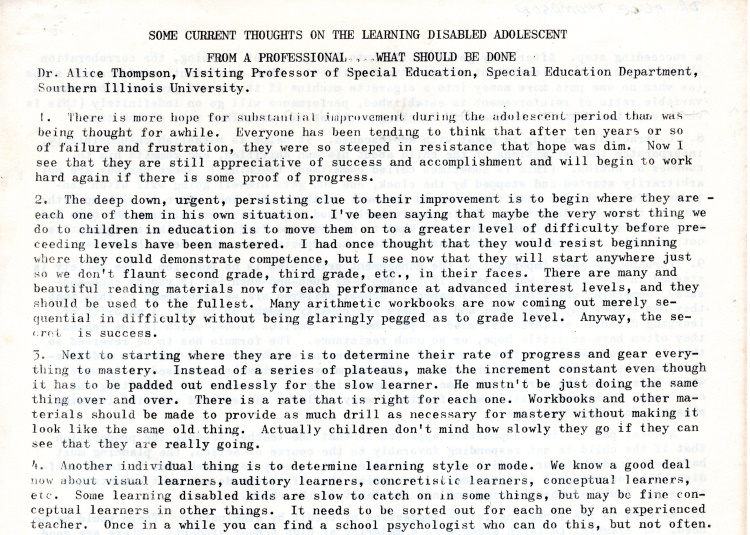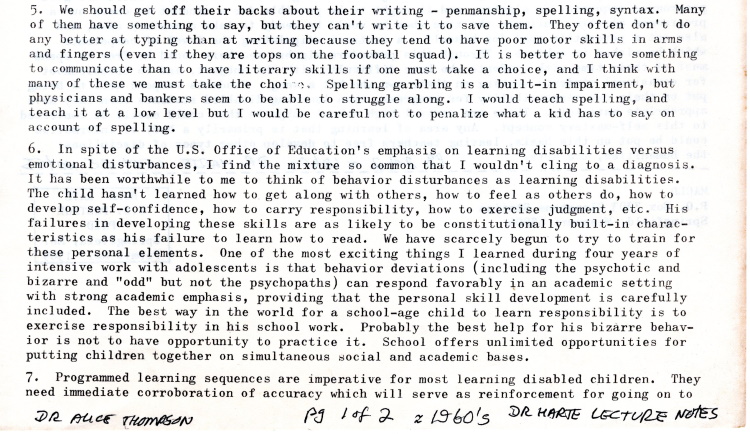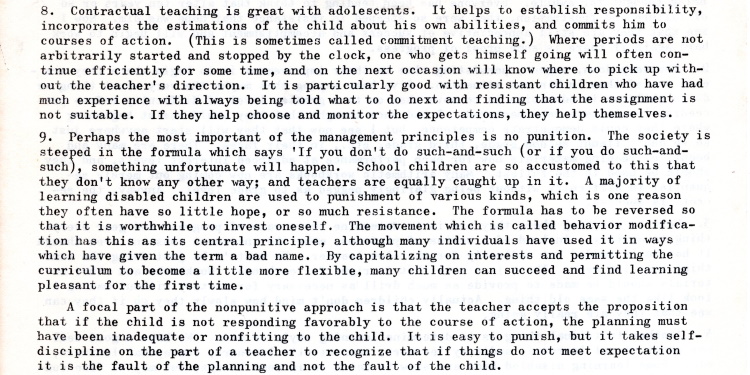1987_10-_27_pg_1_FlemingTemplateUsed.html
1 dr.harte._dr.thompson.lecture.notes.with.commentary.html
The following is first preliminary deposit of Dr. Alice Thompson lecture notes delivered to Dr. Harte medcial doctors focused on child psychiatry.
Right now this is all rough draft.
- ALL IMAGES TO BE CENTERED LATER -
SOME CURRENT THOUGHTS ON THE LEARNING-DISABLED ADOLESCENT FROM A PROFESSIONAL -WHAT SHOULD BE DONE by Dr. Alice Thompson, Visiting Professor of Special Education, Special Education Department, Southern Illinois University.
1.Alice.Thompson.Learning.Disabled.Teen.Pg.1_of_2_full.Pgs
2.Alice.Thompson.Learning.Disabled.Teen.Pg.2_of_2_full.Pgs
1. There is more hope for substantial improvement during the adolescent period than was being thought for awhile. Everyone has been tending to think that after ten years or so of failure and frustration, they were so steeped in resistance that hope was dim. Now I see that they are still appreciative of success and accomplishment and will begin to work hard again if there is some proof of progress.
2. The deep down, urgent, persisting clue to their improvement is to begin where they are - each one of them in his own situation. I've been saying that maybe the very worst thing we do to children in education is to move them on to a greater level of difficulty before preceding levels have been mastered. I had once thought that they would resist beginning where they could demonstrate competence, but I see now that they will start anywhere just so we don't flaunt second grade, third grade, etc., in their faces. There are many and beautiful reading materials now for each performance at advanced interest levels, and they should be used to the fullest. Many arithmetic workbooks are now coming out merely sequential in difficulty without being glaringly pegged as to grade level. Anyway, the secret is success.
3. Next to starting where they are is to determine their rate of progress and gear everything to mastery. Instead of a series of plateaus, make the increment constant even though it has to be padded out endlessly for the slow learner. He mustn't be just doing the same thing over and over. There is a rate that is right for each one. Workbooks and other materials should be made to provide as much drill as necessary for mastery without making it look like the same old thing. Actually, children don't mind how slowly they go if they can see that they are really going.
[Absolutely 100% spot on! > Actually, children don't mind how slowly they go if they can see that they are really going.]
4. Another individual thing is to determine learning style or mode. We know a good deal now about visual learners, auditory learners, concretistic learners,
[Concrete thinking is reasoning that's based on what you can see, hear, feel, and experience in the here and now. It's sometimes called literal thinking, because it's reasoning that focuses on physical objects, immediate experiences, and exact interpretations. https://www.healthline.com/health/concrete-thinking ]
Going to duckduckgo and searching on concretistic learners I get this:
This definition above seems to me what Dr. Thomson is focusing on. Above that entry is also this:
First it helps to know that this entry is referring to the teachings of Karl Jung who was a student of Freud. Therefore, in my opinion you are going to be exposed to some Freudian rubbish and quickly realize that the "8 types of learners .." is what you need to pull up and read.
https://youtu.be/_IopcOwfsoU I am mostly this
But we are most often a blend of different learning styles rather than being a "this type learning …" We are strong is some learning styles and weak in others. And by adulthood we are also a blend of both concrete thinking and abstract thinking. Some people are more concrete in their thinking and viseversa.
So now you can see how powerful are the resources now available to anyone with a low priced computer and an internet connection. Learn the basic principles and then you are off to a good start in learning on your own. But, in my opinion this DOES NOT apply to children, say under age 14, for many reasons. Because education involves much more than learning facts or how to multiply and divide.
conceptual learners, etc.
Some learning disabled kids are slow to catch on in some things, but may be fine conceptual learners in other things. It needs to be sorted out for each one by an experienced teacher. Once in a while you can find a school psychologist who can do this, but not often. [That is sure true}
5. We should get off their backs about their writing - penmanship, spelling, syntax. Many of them have something to say, but they can't write it to save them. They often don't do any better at typing than at writing because they tend to have poor motor skills in arms and fingers (even if they are tops on the football squad). It is better to have something to communicate than to have literary skills if one must take a choice, and I think with many of these we must take the choice. Spelling garbling is a built-in impairment, but physicians and bankers seem to be able to struggle along. I would teach spelling, and teach it at a low level but I would be careful not to penalize what a kid has to say on account of spelling.
6. In spite of the U.S. Office of Education's emphasis on learning disabilities versus emotional disturbances, I find the mixture so common that I wouldn't cling to a diagnosis. It has been worthwhile to me to think of behavior disturbances as learning disabilities.
[… to think of behavior disturbances as learning disabilities. Absolutely right! Think about it. Why is she correct?]
The child hasn't learned how to get along with others, how to feel as others do, how to develop self-confidence, how to carry responsibility, how to exercise judgment, etc. His failures in developing these skills are as likely to be constitutionally built-in characteristics as his failure to learn how to read. We have scarcely begun to try to train for these personal elements. One of the most exciting things I learned during four years of intensive work with adolescents is that behavior deviations (including the psychotic and bizarre and "odd" but not the psychopaths) can respond favorably in an academic setting with strong academic emphasis, providing that the personal skill development is carefully included.
The best way in the world for a school-age child to learn responsibility is to exercise responsibility in his school work. Probably the best help for his bizarre behavior is not to have opportunity to practice it. School offers unlimited opportunities for putting children together on simultaneous social and academic bases.
7. Programmed learning sequences are imperative for most learning-disabled children. They need immediate corroboration of accuracy which will serve as reinforcement for going on to a succeeding step. After they get a little into the groove of learning, the corroboration should begin to be intermittent rather than consistent. When consistent reinforcement stops (as when no one puts more money into a cigarette machine if it doesn't produce); but when a variable ratio of reinforcement is established, performance will go on indefinitely (this is what keeps Las Vegas in business). Teaching machines are excellent part of the time.
8. Contractual teaching is great with adolescents. ...
[I disagree with this method of Contractual Teaching if what she is saying is that we "make a contract with the student to perform, give results, and in effect "to live up to his contract that he has signed" It depends on what that student's reaction to "failing" is. If "failing" is to the student a confirmation of his belief that he IS a failure, then not living up to the contract he has made simply reinforces his belief that he is a failure. You have got to know before you make this contract with the student – how does he see himself if he fails to live up to the contract? Because imposing such a contract may in actuality create a threat to his sense of self-worth. I think the last thing you want to do is to create a possible threat to that student's sense of self-worth – the way he pictures himself. By requiring a "contract" in such people you are actually introducing a negative feed-back loop that will reinforce the persons sense of feeling he is a failure. And this can and is often destructive to him. It sounds good – that you are going to teach him "responsibility". But what you are actually doing is creating a new threat to his self-esteem.]
... to recognize that in some children and teens - It helps to establish responsibility, incorporates the estimations of the child about his own abilities, and commits him to courses of action. (This is sometimes called commitment teaching:)
Where periods are not arbitrarily started and stopped by the clock, one who gets himself going will often continue efficiently for some time, and on the next occasion will know where to pick up without the teacher's direction. It is particularly good with resistant children who have had much experience with always being told what to do next and finding that the assignment is not suitable. If they help choose and monitor the expectations, they help themselves.
[In my opinion, the first step to successful education is help to student to come to believe in himself as a good person who is able to succeed and to constantly reinforce by evidence that he can see this for himself – that he is able to learn and succeed. to build up the student's sense of self-worth, his self-esteem. Insisting that a child or teen must learn a bunch of facts is pointless if all you accomplish is that the student quits trying and then when he can – quits school. Because the way of so much of public school - is to reinforce the student's sense of being a failure.
If the child, the student senses that you are patronizing him, treating him in a condescending manner, showing him an interest in him and a kindness that is insincere and phony – he will spot it right off and then your relationship and establishment of trust will amount to nothing for he will see you for the phony you are. – more later -- ]
It helps to establish responsibility, incorporates the estimations of the child about his own abilities, and commits him to courses of action. (This is sometimes called commitment teaching:) Where periods are not arbitrarily started and stopped by the clock, one who gets himself going will often continue efficiently for some time, and on the next occasion will know where to pick up without the teacher's direction. It is particularly good with resistant children who have had much experience with always being told what to do next and finding that the assignment is not suitable. If they help choose and monitor the expectations, they help themselves.
9. Perhaps the most important of the management principles is no punition. The society is steeped in the formula which says 'If you don't do such-and-such (or if you do such-and such), something unfortunate will happen. School children are so accustomed to this that they don't know any other way; and teachers are equally caught up in it.
A majority of learning-disabled children are used to punishment of various kinds, which is one reason they often have so little hope, or so much resistance. The formula has to be reversed so that it is worthwhile to invest oneself. The movement which is called behavior modification has this as its central principle, although many individuals have used it in ways which have given the term a bad name. By capitalizing on interests and permitting the curriculum to become a little more flexible, many children can succeed and find learning pleasant for the first time. A focal part of the nonpunitive approach is that the teacher accepts the proposition that if the child is not responding favorably to the course of action, the planning must have been inadequate or non-fitting to the child. It is easy to punish, but it takes self-discipline on the part of a teacher to recognize that if things do not meet expectation it is the fault of the planning and not the fault of the child.
10. Related to the foregoing is the suggestion of credit by examination. There would be no need, for example, to teach algebra to a majority of high school students. There are good programmed sequences in algebra, and it ought to be possible for a student to check out a programmed algebra, estimate the time when he would be ready to take a mastery exam, and also set a percentile goal for himself - a contract stipulating the level of competence which he wished to achieve. Through this procedure algebra teachers would be free to spend most of their time with students who have difficulty with the subject, and to troubleshoot for occasional students working on their own who hit a snag. Students respond well to being put on their own responsibility for progress, even learning-disabled students when they have appropriate materials. There are several high school subjects that could easily be converted to this self-mastery concept. Any area of learning that is primarily a body of information could be put on this basis, leaving teachers free to develop other types of disciplines: the humanities, the arts.
From Dr. James R. Harte, M.D., lecture notes for young medical doctors pursuing a career in child psychiatry. Mid 1960s
Full two page text - exact images
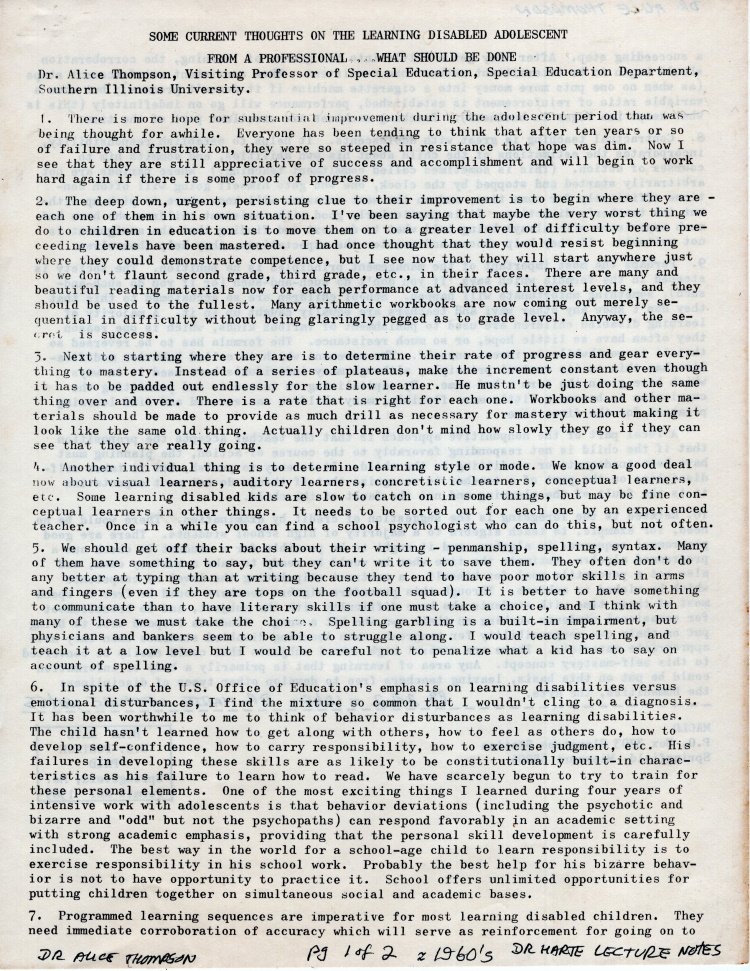
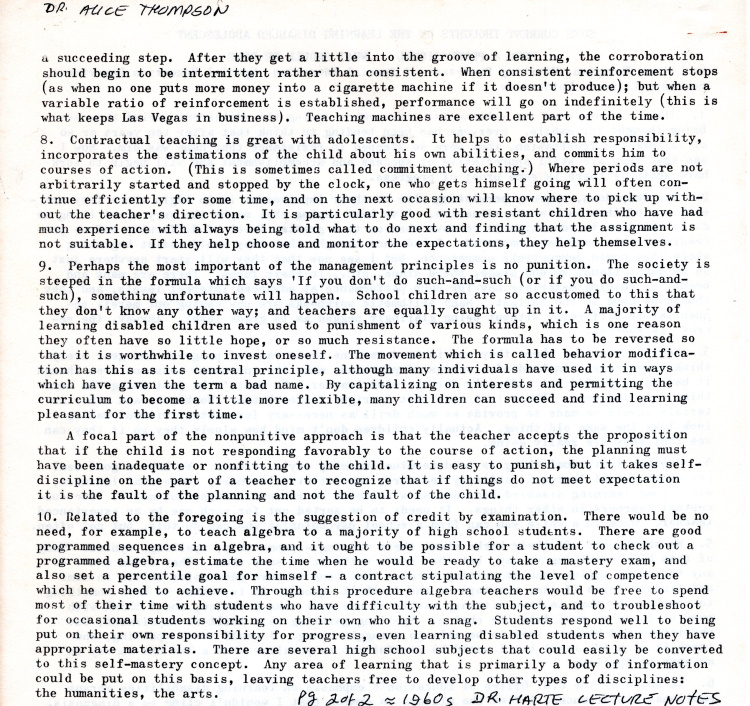
text details follow
